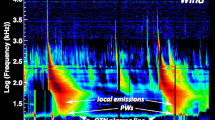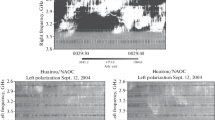Abstract
The theory of plasma emission is developed under the assumption that the Langmuir waves are generated by an isotropic distribution of fast electrons. Emission from inverse power-law distributions tend to favor emission at the second harmonic with brightness temperatures up to about 108 K at 100 MHz. The concept of a gap (in velocity space) distribution is developed. Very bright plasma emission can result from a gap distribution. For brightness temperatures between 109 K and 1011 K for the second harmonic the fundamental has a brightness temperature between 108 K and 109 K. For higher brightness temperatures the fundamental is amplified and can be very much brighter than the second harmonic. The maximum brightness temperatures for the fundamental and second harmonic at 100 MHz are about 1016 K and 1013 K respectively. Mechanisms by which a gap distribution might be formed are discussed and two effective mechanisms are identified.
The theory is applied to the interpretation of radio bursts of types I, II, stationary IV and V. In each case the suggested mechanism appears to be favorable.
Similar content being viewed by others
References
Bekefi, G.: 1966, Radiation Processes in Plasmas, Wiley, New York.
Dulk, G. A., Gosling, J. T., McQueen, R. M., Magun, A., Robinson, R. D., Sheridan, K. V., and Stewart, R. T.: 1975, in preparation.
Fung, P. C. W. and Yip, W. K.: 1966, Aust. J. Phys. 19, 759.
Lin, R. P., Evans, L. G., and Fainberg, J.: 1973, Astrophys. Lett. 14, 191.
Melrose, D. B.: 1970a, Aust. J. Phys. 23, 871.
Melrose, D. B.: 1970b, Aust. J. Phys. 23, 885.
Melrose, D. B.: 1973a, Aust. J. Phys. 26, 299.
Melrose, D. B.: 1973b, Proc. Astron. Soc. Australia 2, 208.
Melrose, D. B.: 1974a, Solar Phys. 35, 441.
Melrose, D. B.: 1974b, Solar Phys. 37, 353.
Melrose, D. B.: 1974c, Proc. Astron. Soc. Australia 2, 261.
Nelson, G. J. and Sheridan, K. V.: 1974, in G. Newkirk, Jr. (ed.), ‘Coronal Disturbances’, IAU Symp. 57, 345.
Smerd, S. F., Sheridan, K. V., and Stewart, R. J.: 1974, in G. Newkirk, Jr. (ed.), ‘Coronal Disturbances’, IAU Symp. 57, 389.
Smith, D. F.: 1971, Astrophys. J. 170, 559.
Smith, D. F.: 1972a, Astrophys. J. 174, 121.
Smith, D. F.: 1972b, Astrophys. J. 174, 643.
Sy, W., N.-C: 1973, Proc. Astron. Soc. Australia 2, 215.
Takakura, T.: 1963, Publ. Astron. Soc. Japan 15, 402.
Tidman, D. A.: 1965, Planetary Space Sci. 13, 781.
Tidman, D. A. and Dupree, T. A.: 1965, Phys. Fluids 8, 1860.
Tsytovich, V. N.: 1970, Nonlinear Effects in Plasma, Plenum Press, New York.
Weiss, A. A. and Stewart, R. T.: 1965, Aust. J. Phys. 18, 143.
Zheleznyakov, V. V. and Zaitzev, V. V.: 1968, Soviet Astron. - AJ 12, 14.
Zirin, H. and Tanaka, K.: 1973, Solar Phys. 32, 173.
Author information
Authors and Affiliations
Additional information
Visiting Professor from Australian National University, Canberra, Australia
Rights and permissions
About this article
Cite this article
Melrose, D.B. Plasma emission due to isotropic fast electrons, and types I, II, and V solar radio bursts. Sol Phys 43, 211–236 (1975). https://doi.org/10.1007/BF00155154
Received:
Revised:
Issue Date:
DOI: https://doi.org/10.1007/BF00155154




